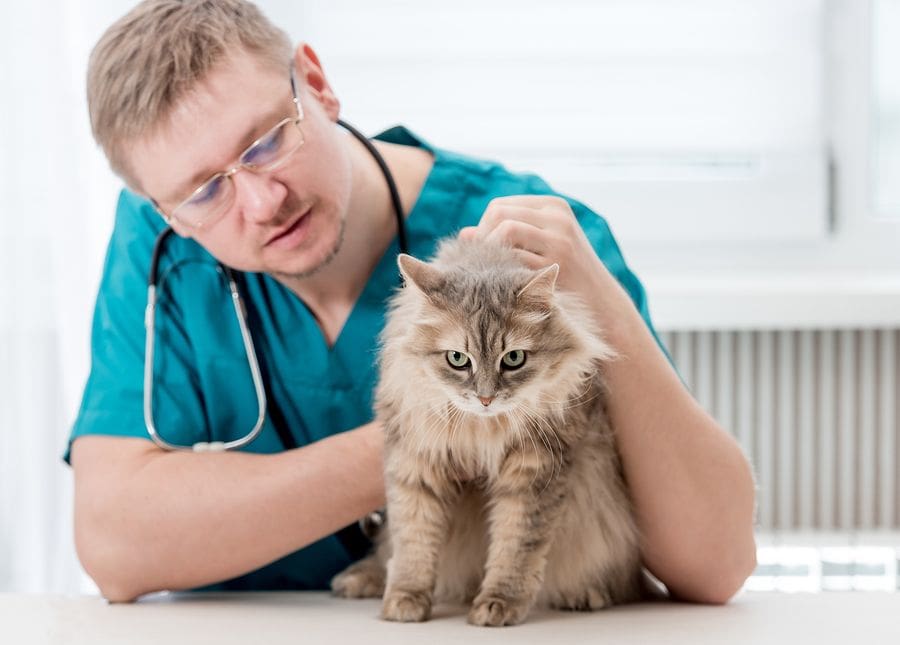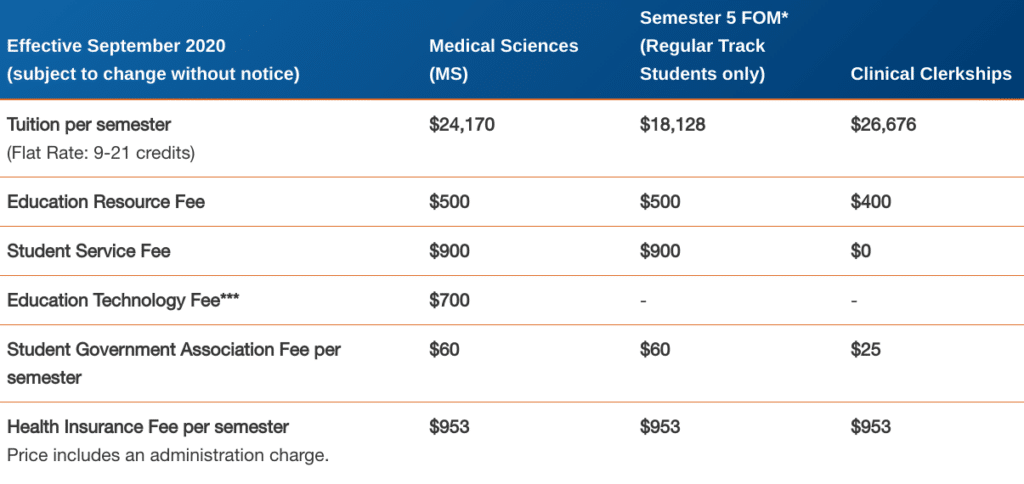
Editor's note: Ross University has been named in the Sweet v. Cardona settlement. This is causing confusion, and we're here to help you understand how it might impact you and your student loans. If you want to talk to an expert, book a plan to discuss it with one of our student loan planners. If you are not worried about the school withholding your transcripts, go ahead and apply for Borrower Defense with the Department of Education.
Perhaps no one else in America has helped more Ross University grads figure out their student loans than I have. While the school provides healthcare degree programs and a path to getting your MD or DVM, Ross University tuition costs are high. And in my view, Ross University does little to warn students of the high loan burden they will face at graduation.

Ross University produces a lot of great physicians and veterinarians. This isn’t me questioning the education so much as the cost.
As I’ll show you later, it’s not unusual to come out of Ross owing more than $400,000 for vet school and more than $500,000 for medical school. In many cases, you will be unable to pay that debt back without federal forgiveness and repayment plans from the U.S. Department of Education.
This post is my own opinion, but I’ll back it up with some cold hard facts. Are you currently dealing with student loans from high Ross University tuition costs? If so, you can check out how I help professionals with high debt loads from medical and veterinary school here.
What is Ross University?

Forgive me if you already know, but Ross University is a for-profit institution located on two separate islands in the Caribbean. They offer DVM degrees through the Ross University School of Veterinary Medicine in St. Kitts and MD degrees through the Ross University School of Medicine, which used to be in Dominica and now is in Barbados.
Ross got bought in 2003 by a giant for-profit college chain. The chain then rebranded itself as Adtalem Global Education, Inc. in 2017. You can find them trading on the NYSE under the ticker ATGE.
Why is any of that relevant to you? Because Ross University wants to make as much money as possible, and you’re the profit center. That creates a ton of incentives to not be transparent.
Get Started With Our New IDR Calculator

Ross University tuition estimates
When you're first starting to research a school, typically, the school website is where most people look first for cost estimates and tuition fees. We'll see later why this can be a mistake. But, for now, let's look at the Ross University tuition estimates published on its site for new and prospective students.
Ross University School of Medicine Tuition
It can be a bit difficult to calculate the total cost of attending Ross University Medical School (RUSM). The reason for this boils down to how the school structures its MD program.
If you're already a Ross University student, then you know that the first two years of the program focus on the “Medical Sciences” curriculum, and the last two years are when students complete their clinical rotations.

Why does this make things confusing? Because Ross charges a different tuition rate for its Medical Sciences and Clinical Clerkship semesters. Here's a screenshot from the financial aid section of their site of the latest Ross University tuition rates, effective September 2020.

The other important point to keep in mind is that Ross University follows a three-semester-per-year schedule (with start dates in September, January and May). So to get a per-year total cost of attendance, you need to multiply the above totals by three. This can be confusing to calculate full-time medical school costs.
When you add up all the numbers in the far-left (MS) column, you get a total per-semester cost of $27,283. Multiply that number by three and you get a per-year MS cost of $81,849. Multiply by two, and you get a two-year cost of $163,698. The Clinical Clerkship per-semester cost is a bit higher, but you won't have to pay a Student Service Fee or Education Technology Fee. Still, the two year-cost comes out to $168,324.
If you simply add these two figures together, you’d assume that you would find a fair estimate of the cost at $332,022. But our average Ross med school client owes far more than that.
Ross University School of Veterinary Medicine tuition
And how much does it cost to earn your Doctor of Veterinary Medicine at Ross? Ross School of Veterinary Medicine tuition is stated to be $13,859 per semester, leading to an annual cost of $41,577.

Unfortunately, cost of attendance estimates calculated strictly from website information are usually wrong (this is for most institutions). You must adjust for accrued interest and increases in the cost of attendance. Plus, the numbers above don't include living expenses.
My rule of thumb is to take any program’s cost estimates and multiply them by 1.25. You’ll get a more accurate guess of the average net price of Ross by accounting for hidden costs.
Stats about Ross University School of Veterinary Medicine
The RUSVM factsheet says that the median total debt of graduates of the vet school program for students who graduated in 2020 was $312,203. It also says its official 2018–19 NAVLE pass rate was 83%.
You'll notice that these stats haven't been updated to include the 2021 graduating class. Also, there's no mention of the percentage of Ross vet students graduating in the 42-month program. I would love to see data about the number of withdrawals per first-year student and the graduation rate.
Stats about Ross University School of Medicine
The Ross University School of Medicine factsheet is very similar to the DVM program's factsheet. The RUSM tuition rates and debt data are for students who graduated in the 2019-2020 school year. It says that the median tuition, books and fees paid by graduates was $$262,638, and the median student debt was $379,087.
The actual cost of Ross University that I’ve encountered
There are a lot of ways to massage statistics so that they paint a rosy picture. For example, the RUSM fact sheet touted the school’s 0.9% default rate compared to the national average at all foreign Title IV eligible schools.
To that, I say, OF COURSE! If you’re smart enough to survive and graduate from Ross Medical School or Vet School, you’ll learn about Public Service Loan Forgiveness eligibility, Income-Driven Repayment and forgiveness options, and cutting costs on interest through refinancing.
This is one example of highly misleading admissions materials I found while researching this post. If the school wanted to be fair, they would compare default rates only among other medical schools and veterinary schools, and they would look at the percentage of students paying down at least $1 of the principal within 3 years.
Here are the actual student loan balances I’ve seen from Ross University graduates who booked a plan with me.
| Ross University program | Average debt |
|---|---|
| Veterinary Medicine (DVM) | $390,000 |
| Medical School (MD) | $498,000 |
One explanation for these numbers is that some professionals contact us a few years after graduation. You might not have thought about your loans the first day after graduation, of course. That’s when Ross reports their data to the Department of Education.
Ironically, since the school has been able to tap federal student aid, costs have continued to soar while students feel less of the actual expense. That’s because Ross students used to rely heavily on private loans. Federal student loans now offered to students have more generous repayment options.
Ross University must pay for placements
Since Ross isn’t affiliated with any teaching hospitals, the school must pay for clinical rotations in the U.S. Many Caribbean medical school programs like St. George’s have this same issue.
Not long ago, Ross paid $35 million for rotation slots in Kern County, California, for its med students. I expect the vet school makes big payments to its affiliate hospitals for its students’ clinical year in the U.S. The students are the ones who ultimately foot the bill for these paid placements in the form of higher Ross University tuition.
Dealing with Ross University student loans

For example, pretend Maggie graduates Ross med school with $425,000 of student debt and Tim leaves with $350,000 from vet school, all at 7% interest. Both ignore their loans for the first couple of years after graduation.
Forbearance, capitalization and interest growth happen. Now Maggie owes $484,500, and Tim owes $399,000.
Maggie, the Ross pediatrician
Maggie works as a pediatrician in a big hospital system in Atlanta. Tim works at a VCA clinic in St. Louis.
Maggie is eligible for Public Service Loan Forgiveness. She has one year left of residency at a $60,000 salary. She then earns an attending income of $160,000, adjusted upwards for inflation. Here’s PSLF vs. private refinancing at 5%.
| Option | PSLF (10 years) | Refinancing (10 years at 5%) |
|---|---|---|
| Payment | $148,117 | $630,230 |
| Balance | $675,533 | N/A |
| Tax bomb | N/A | N/A |
| Total cost | $148,117 | $630,230 |
PSLF has massive savings over refinancing. However, there are so many ways Maggie could save money, it’s not even funny. She could’ve started making payments earlier, consolidated her loans strategically, or focused on retirement savings.
We didn’t even model the impact of getting married. Let’s look at Tim, the veterinarian, now.
Tim the Ross veterinarian
Since Tim works at VCA, a private employer, he must pay over 20 years under the Pay As You Earn (PAYE) plan to reach forgiveness. He must also pay taxes on the forgiven balance. This is a big difference from what Maggie experiences since she works at a not-for-profit employer.
Look at the 20-year cost below, assuming Tim earns $75,000 per year and remains single.
| Option | Payment | Balance | Tax bomb | Total cost |
|---|---|---|---|---|
| PAYE (20 years) | $153,645 | $803,955 | $321,582 | $475,227 |
| Refinancing (10 years at 5%) | $519,013 | N/A | N/A | $519,013 |
Tim is better off paying a total of $475,227 over 20 years instead of $519,013.
Get custom help understanding Ross University student debt
I don’t believe you can trust a for-profit school to act in your best interest.
Financial aid, admissions and administration answer to the owners of the school and Wall Street. They’re probably good people. But their incentives are not aligned to make sure you get the best advice on your financial future.
In fact, Business Insider reported in August 2022 that students from Ross University were part of a class action lawsuit and part of a settlement wiping out debt, thanks to the Sweet v. Cardona case.
If the school brings in a group to give a presentation, that group can’t risk offending the school since they’re paying the bills.
That’s why we work directly for borrowers like you to avoid this conflict of interest. I’m assuming Ross won’t be inviting me to speak anytime soon. I prefer to talk one-on-one and create custom plans instead of giving generic tips about how to pay back med or vet school loans.
If you’re trying to figure out how to pay hundreds of thousands of student debt from Ross University, my team and I would love to make a plan for you. And we can hopefully save you a lot of money projected over the life of your loan repayment.
These are scenarios we try to answer for you with our student loan planning service, and we’ve advised over $2.2 billion in student loan debt since we started. If pursuing a forgiveness program is your best option, we'll let you know that. And if refinancing is best, we can help you compare lenders.
The good news is I’ve never met someone who was beyond help, no matter how high your student loan balance ended up being.
What’s your opinion of Ross University and the cost of attendance? Share your opinion below!
Not sure what to do with your student loans?
Take our 11 question quiz to get a personalized recommendation for 2024 on whether you should pursue PSLF, Biden’s New IDR plan, or refinancing (including the one lender we think could give you the best rate).

I’m a Ross Grad Vet School
High debt as well
You finished! I’ve heard a lot of stories from folks who didn’t get the degree but have a lot of debt. There’s still strategies for both but it’s better to have the dvm or md than not once you have six figures of loans from Ross
Just graduated … contact me
Hello Carla,
I am getting ready to take the plunge into vet school and was accepted into both Ross and St. George’s. I was just curious if you had any tips on going to Ross and how you feel about your overall education there. What is your debt like? Do you feel you made the right choice going to Ross? Thank you so much! If you have any advice you’d like to share I will gladly give you my email address.
Emily
Hopefully Carla responds but I’d say that most veterinarians I speak with from Ross and St. George’s are happy they decided to become vets, but most wish they had done it a different way. Maybe about 20% or 30% feel like they made a huge mistake going to vet school at all after their 400k debt load they borrow.
Graduated from the medical school and in 4th year of residency. What do I need to focus on when I start making an attending salary?
Make sure you don’t make a big mistake with PSLF. If your job is eligible go for forgiveness: studentloanplanner.com/public-service-loan-forgiveness/
If it’s not, you need to decide if refinancing is the way to go or not. It probably is if you’re private practice and your debt to income ratio is below 1.5 to 1.
2014 Ross Vet grad. Part of the confusion at the beginning is that the RUSVM curriculum is 10 semesters not 8 (7 on island and 3 stateside in clinics). If you take the estimated $77k for 2 semesters then multiple that by 5 you get a more accurate number. It is crippling debt no matter how you calculate it. I graduated with around $340k and am over $400k now making payments monthly since graduating. There is no end in sight.
That makes a lot of sense Lindsey. Almost all Ross vets I speak to are utilizing an income driven forgiveness option. That’s really interesting they’re able to charge an additional three semesters of tuition when you’re not even on the island.
Travis- Students have to do their clinical rotations (3 semesters) at an AVMA-accredited veterinary school off of the island. Placements are made with clinical affiliate schools in the US, UK, Canada, New Zealand, or Ireland. Even though students are no longer on the island, they still have to pay tuition to go toward those placements. Students pay tuition to Ross, who pays these affiliate schools.
Lindsey, I’m glad you pointed this out. I advise students and I’ve been trying to get through to one of them about the drastic difference in tuition between Ross and a US school, because she is choosing Ross over her stateside admittance. She made a cost comparison chart (I think to try to prove to me that it’s not that big of a difference) but she was off by about $100K with tuition and fees because she didn’t include enough semesters! Ross is close to double the cost of attendance when compared to the stateside school, even with it being a private institution. Even though it is located in her home state, the cost is still quite a bit higher than public in-state tuition would be. That is telling for how expensive Ross really is!
I remember my daughter being excited heading off to Ross to pursue her dream of becoming a DVM. She graduated in 2014 with around 200K in debt as she lived like a starving student. Upon her graduation she was living at home to minimize costs so she could get after her loans. After roughly 6 months she seemed depressed. I thought maybe a bad day at work so I asked her what was wrong? She said Dad, I did everything right and here I am 28 years old living with my parents and seeing a good part of my loan payment going towards interest. I am by no means a wealthy person, but I did have enough in home equity to pay off her loans which I did. I then made her an 180,000.00 loan at zero interest for 10 years which is $1,500.00 a month. She moved out a couple of years ago and got a roommate and lives frugally. She is paying all she can to get this loan behind her and since 1/1/15 she has paid off $87,500.00 of the original loan. My guess is she will have this loan paid off in another 3 to 4 years. I’m able to write off some of the mortgage interest. I also had her take out disability insurance to protect her income and ability to make the payment and required her to take a life insurance policy for $180K in case was to happen to her.
I mention this story so that other parents that might be able to look at their assets and see if there is way assist their kids without risking their own future or retirement. Come on parents you’ve raised a great young adult and I know you’re proud of them. Do what you can to help.
All the best, KLK
I commend you for wanting and being willing to help Ken. I’d strongly encourage any parents or students to get an expert opinion first before doing something like that because it has some huge implications. For example you can’t write off mortgage interest anymore for non real estate related uses with the new tax law for new mortgages. That’s just 1 example of something that would be easy to overlook.
I understand and agree to always get professional tax and financial advice which I did do as everyones situation is different. I applaud you for what you’re doing to help both students and parents to a happy and prosperous future.
Is there any way to find what percentage of students who start the program finish the program (Ross Veterinary Medicine)? I saw the percentage of students who finish on time (out of total students who finished during that year), but I’m curious how many students don’t finish AT ALL/fail out.
I would imagine the data is not great. This is what I found claims a pass rate of 83% for the NAVLE https://veterinary.rossu.edu/media/4241/rusvm_knowbeforeyougo08-13-18.pdf
Ross will kick you out if you fail 2 classes (in the same semester or different semesters). We lose about 30% of our students before clinics if I had to estimate (so not even at the point of taking the NAVLE). I was looking for some statistics for that instead of an estimate.
I’m also trying to find these statistics and Ross doesn’t post them anywhere, likely for good reason on their part. I advise pre-vet and vet students and I want to give them all of the facts about Ross before they make the decision to attend. Many of them will take all these loans not knowing their implications or how they will affect their lives later, because that number means nothing to them right now.
Do you also go over the tuition fees RUSM charged us in the four years of school? I feel like they may have overcharged me for tuition and when speaking to them they just go around in circles with no real answer.
Problem there is that they increase it significantly every year. So you want to plan for 5% per year tuition hikes over and above what they tell you when you enroll
I’m scared to see what Canadian’s student debt from the Ross University end up with. I’m guessing 500 K-600K since Canadian dollar value is less than US.
Travis – my daughter has been accepted at Ross U vet school for the fall of 2020. As I look at the tuition, fees and room & board listed on their website, I I see a total tuition for 10 semesters of $208,726 plus 10 semesters of R & B which comes to about $42,500, and then about $15,000 per year for travel, personal, etc. That comes to about $312,000 all in. With 5% annual increases, that would be about $335k. I want to be sure I am not missing anything else I should be considering based on your comments that not all costs are apparent. I understand that I am not considering interest or loan fees.
The final bill might be different than your projections – it’s tough to account for every single thing. I’d suggest you look at our pre-debt consult to get peace of mind about what student loans might look like after graduation.
On campus housing can only be used the first semester (and is required that first semester) so make sure to research how much a rental will cost for the remaining time she’ll be on the island.